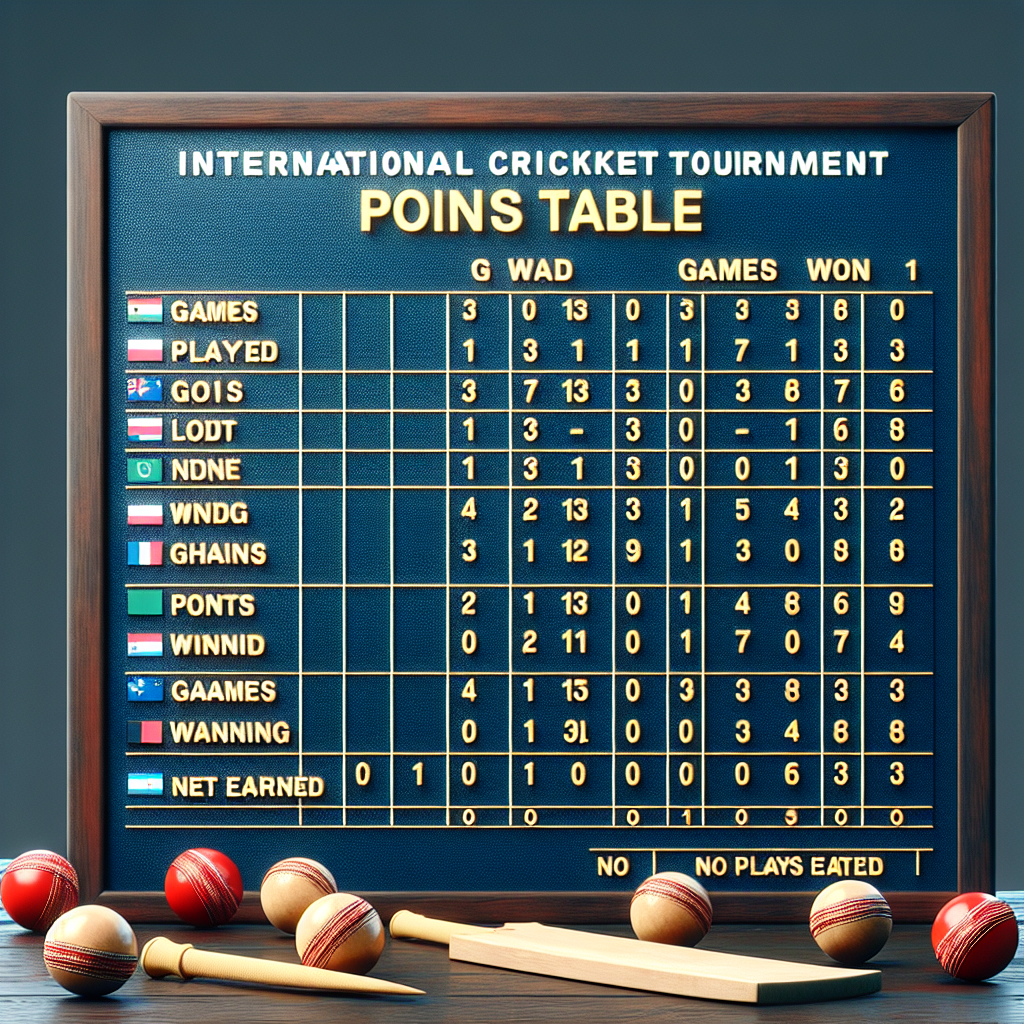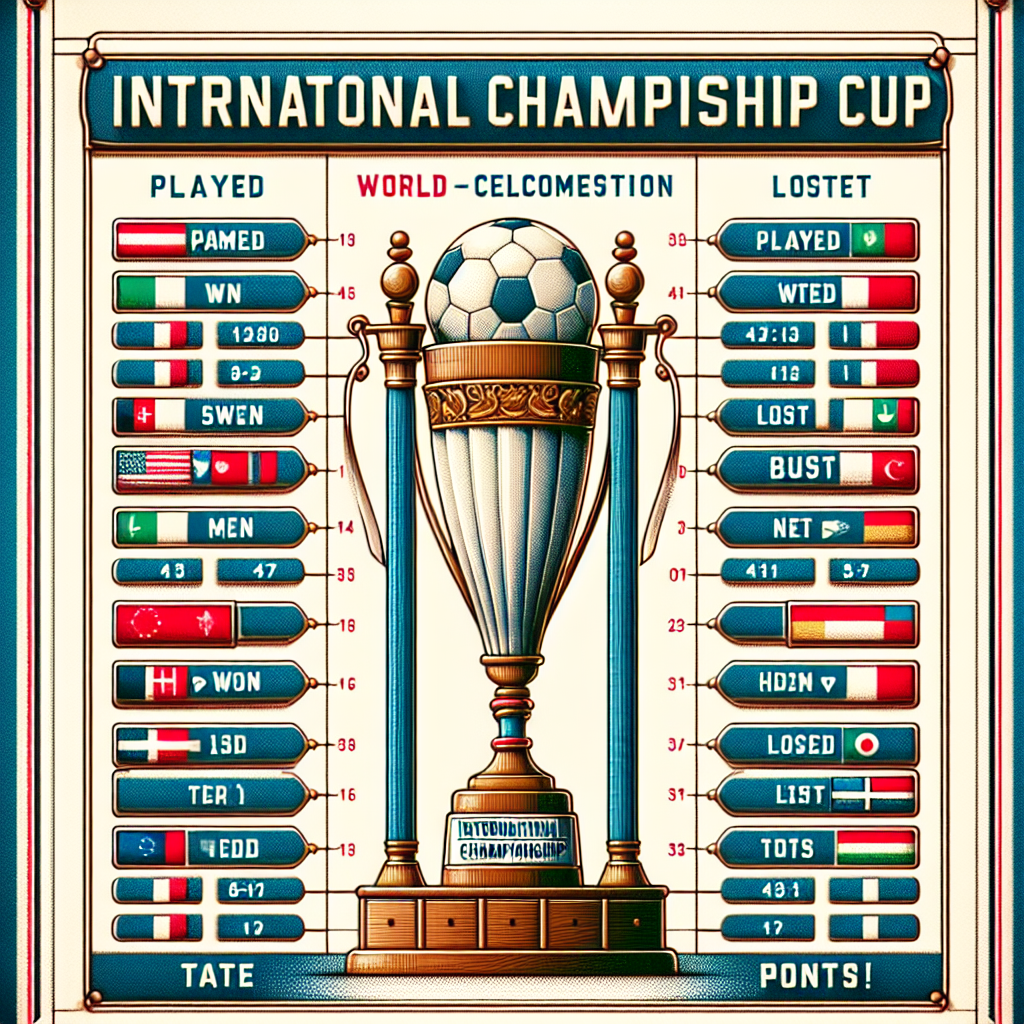
The ICC World Cup is one of the most prestigious tournaments in the world of cricket, bringing together the best teams from across the globe to compete for the ultimate prize. A critical component of this tournament is the points table, which plays a pivotal role in determining which teams advance to the knockout stages. This article delves into the intricacies of the ICC World Cup points table, exploring its structure, significance, and impact on the tournament's progression.
The Structure of the ICC World Cup Points Table
The points table is a dynamic leaderboard that reflects the performance of each team throughout the tournament. It is updated after every match and serves as a snapshot of the current standings. The table typically includes the following columns:
- Team: The name of the participating team.
- Matches Played (M): The total number of matches a team has played.
- Wins (W): The number of matches a team has won.
- Losses (L): The number of matches a team has lost.
- No Result (NR): Matches that ended without a result, often due to weather conditions.
- Points (Pts): The total points a team has accumulated. Typically, a win earns a team 2 points, a no-result earns 1 point, and a loss earns 0 points.
- Net Run Rate (NRR): A statistical measure used to break ties between teams with equal points. It is calculated based on the runs scored and conceded per over.
Significance of the Points Table
The points table is not just a record of wins and losses; it is a strategic tool that influences team strategies and decisions. Here are some reasons why the points table is significant:
Determining Standings and Progression
The primary function of the points table is to rank teams based on their performance. The top teams on the table advance to the knockout stages, making every match crucial. For instance, in the 2019 ICC World Cup, New Zealand advanced to the semi-finals over Pakistan due to a superior net run rate, despite both teams having the same number of points.
Strategic Decision-Making
Teams often use the points table to strategize their approach to upcoming matches. A team with a strong position on the table might choose to rest key players, while a team on the brink of elimination might adopt a more aggressive strategy to secure a win and improve their net run rate.
Fan Engagement and Excitement
The points table adds an element of excitement and engagement for fans. As the tournament progresses, fans closely monitor the table to see how their favorite teams are performing and what they need to do to advance. This engagement is further amplified by the media, which provides in-depth analysis and predictions based on the points table.
Case Studies: Impact of the Points Table in Past ICC World Cups
2011 ICC World Cup: The Rise of India
The 2011 ICC World Cup saw India emerge as champions on home soil. Throughout the tournament, India maintained a strong position on the points table, finishing second in their group. This strategic positioning allowed them to face Australia in the quarter-finals, a match they won convincingly. India's consistent performance on the points table was a testament to their balanced team and strategic planning.
2015 ICC World Cup: New Zealand's Unbeaten Streak
In the 2015 ICC World Cup, New Zealand dominated the points table by winning all their group stage matches. Their unbeaten streak ensured they finished at the top of their group, giving them a favorable path to the finals. Although they eventually lost to Australia in the final, their performance on the points table highlighted their dominance throughout the tournament.
2019 ICC World Cup: The Net Run Rate Decider
The 2019 ICC World Cup was notable for the role of net run rate in determining the semi-finalists. Both New Zealand and Pakistan finished the group stage with 11 points, but New Zealand's superior net run rate allowed them to advance. This scenario underscored the importance of not just winning matches but also winning them convincingly to maintain a healthy net run rate.
Statistics and Trends in ICC World Cup Points Tables
Analyzing past ICC World Cup points tables reveals several interesting trends and statistics:
- Consistency is Key: Teams that consistently perform well in the group stages often advance to the knockout rounds. For example, Australia has consistently topped their group in multiple World Cups, leading to their successful campaigns.
- Impact of Weather: Weather conditions can significantly impact the points table. Matches affected by rain often result in no-results, which can alter the standings. The 2003 World Cup saw several matches affected by rain, impacting the final standings.
- Importance of Net Run Rate: As seen in the 2019 World Cup, net run rate can be a decisive factor. Teams often focus on not just winning but winning by large margins to boost their net run rate.
Conclusion: The Points Table as a Crucial Element of the ICC World Cup
The points table is an integral part of the ICC World Cup, serving as a barometer of team performance and a strategic tool for both teams and fans. It influences team strategies, determines tournament progression, and adds an element of excitement and engagement for fans worldwide. As seen in past tournaments, understanding and leveraging the points table can be the difference between advancing to the knockout stages or facing an early exit. As cricket continues to evolve, the points table will remain a crucial element in the narrative of the ICC World Cup, shaping the strategies and outcomes of this prestigious tournament.





